Thymoquinone Potentiates the Effect of Phenytoin against Electroshock-Induced Convulsions in Rats by Reducing the Hyperactivation of m-TOR Pathway and Neuroinflammation: Evidence from In Vivo, In Vitro and Computational Studies
Abstract
1. Introduction
2. Results
2.1. Impact of Phenytoin (PHT), Thymoquinone (THQ) Alone and in Combination Therapy against Electroshock-Induced THLE
2.2. Impact of Phenytoin (PHT), Thymoquinone (THQ) Alone and in Combination Therapy on Recovery Time Post Electroshock-Induced Convulsions
2.3. Effect of Phenytoin (PHT), Thymoquinone (THQ) Alone and in Combination Therapy on Hippocampal mTOR Levels
2.4. Effect of Phenytoin (PHT), Thymoquinone (THQ) Alone and in Combination Therapy on Inflammatory Markers in Hippocampus
2.4.1. Effect on Hippocampal IL-1β Levels
2.4.2. Effect on Hippocampal IL-6 Levels
2.4.3. Effect on Hippocampal TNF-α Levels
2.5. Effect of Phenytoin (PHT), Thymoquinone (THQ) Alone and in Combination Therapy on Hippocampal Neuronal Damage
2.6. Effect of Phenytoin (PHT), Thymoquinone (THQ) Alone and in Combination Therapy on PTZ-Induced Cellular Degeneration on HEK-293 Cells
2.7. Molecular Docking
3. Discussion
4. Materials and Methods
4.1. Animals
4.2. Drugs and Dosing Plan
4.3. Experimental Groups
4.4. MES-Induced Tonic Hind Limb Extension (THLE)
4.5. Experimental Design
4.6. MES-Induced Neuronal Damage
4.7. Assessment of Hippocampal m-TOR Levels
4.8. Assessment of Proinflammatory Markers in the Hippocampus
4.9. In Vitro Studies
4.9.1. Cell Culture
4.9.2. In Vitro Model of Cellular Degeneration
4.9.3. Treatment with Test Drugs
4.9.4. MTT Assay
4.10. Molecular Modeling
4.11. Statistical Analysis
5. Conclusions
Author Contributions
Funding
Institutional Review Board Statement
Informed Consent Statement
Data Availability Statement
Acknowledgments
Conflicts of Interest
References
- Sarmast, S.T.; Abdullahi, A.M.; Jahan, N. Current Classification of Seizures and Epilepsies: Scope, Limitations and Recommendations for Future Action. Cureus 2020, 12. [Google Scholar] [CrossRef] [PubMed]
- Pottoo Impact of Adherence to Antiepileptic Medications on Quality of Life of Epileptic Patients in the Eastern Province of Saudi Arabia: A Cross-Sectional Study. Available online: http://www.e-ijas.org/article.asp?issn=2589-0603;year=2020;volume=5;issue=1;spage=1;epage=8;aulast=Pottoo (accessed on 17 January 2020).
- Beghi, E. The Epidemiology of Epilepsy. NED 2020, 54, 185–191. [Google Scholar] [CrossRef] [PubMed]
- Thijs, R.D.; Surges, R.; O’Brien, T.J.; Sander, J.W. Epilepsy in Adults. Lancet 2019, 393, 689–701. [Google Scholar] [CrossRef]
- Fiest, K.M.; Sauro, K.M.; Wiebe, S.; Patten, S.B.; Kwon, C.-S.; Dykeman, J.; Pringsheim, T.; Lorenzetti, D.L.; Jetté, N. Prevalence and Incidence of Epilepsy: A Systematic Review and Meta-Analysis of International Studies. Neurology 2017, 88, 296–303. [Google Scholar] [CrossRef] [PubMed]
- Hanada, T. Ionotropic Glutamate Receptors in Epilepsy: A Review Focusing on AMPA and NMDA Receptors. Biomolecules 2020, 10, 464. [Google Scholar] [CrossRef]
- Subbarao, B.S.; Silverman, A.; Eapen, B.C. Seizure Medications. In StatPearls; StatPearls Publishing: Treasure Island, FL, USA, 2021. [Google Scholar]
- Saxton, R.A.; Sabatini, D.M. MTOR Signaling in Growth, Metabolism, and Disease. Cell 2017, 168, 960–976. [Google Scholar] [CrossRef]
- Laplante, M.; Sabatini, D.M. MTOR Signaling at a Glance. J. Cell Sci. 2009, 122, 3589–3594. [Google Scholar] [CrossRef]
- Liu, R.; Chen, Y.; Liu, G.; Li, C.; Song, Y.; Cao, Z.; Li, W.; Hu, J.; Lu, C.; Liu, Y. PI3K/AKT Pathway as a Key Link Modulates the Multidrug Resistance of Cancers. Cell Death Dis. 2020, 11, 1–12. [Google Scholar] [CrossRef]
- LiCausi, F.; Hartman, N.W. Role of MTOR Complexes in Neurogenesis. Int. J. Mol. Sci. 2018, 19, 1544. [Google Scholar] [CrossRef]
- Switon, K.; Kotulska, K.; Janusz-Kaminska, A.; Zmorzynska, J.; Jaworski, J. Molecular Neurobiology of MTOR. Neuroscience 2017, 341, 112–153. [Google Scholar] [CrossRef]
- Ahmad, M.A.; Pottoo, F.H.; Akbar, M. Gene Therapy Repairs for the Epileptic Brain: Potential for Treatment and Future Directions. Curr. Gene Ther. 2019, 19, 367–375. [Google Scholar] [CrossRef]
- Borkowska, J.; Schwartz, R.A.; Kotulska, K.; Jozwiak, S. Tuberous Sclerosis Complex: Tumors and Tumorigenesis. Int. J. Dermatol. 2011, 50, 13–20. [Google Scholar] [CrossRef]
- Hasbani, D.M.; Crino, P.B. Chapter 52-Tuberous sclerosis complex. In Handbook of Clinical Neurology; Geschwind, D.H., Paulson, H.L., Klein, C., Eds.; Neurogenetics, Part II; Elsevier: Amsterdam, The Netherlands, 2018; Volume 148, pp. 813–822. [Google Scholar]
- Kwiatkowski, D.J.; Choueiri, T.K.; Fay, A.P.; Rini, B.I.; Thorner, A.R.; de Velasco, G.; Tyburczy, M.E.; Hamieh, L.; Albiges, L.; Agarwal, N.; et al. Mutations in TSC1, TSC2, and MTOR Are Associated with Response to Rapalogs in Patients with Metastatic Renal Cell Carcinoma. Clin. Cancer Res. 2016, 22, 2445–2452. [Google Scholar] [CrossRef]
- LaSarge, C.; Danzer, S. Mechanisms Regulating Neuronal Excitability and Seizure Development Following MTOR Pathway Hyperactivation. Front. Mol. Neurosci. 2014, 7, 18. [Google Scholar] [CrossRef] [PubMed]
- Ryskalin, L.; Lazzeri, G.; Flaibani, M.; Biagioni, F.; Gambardella, S.; Frati, A.; Fornai, F. MTOR-Dependent Cell Proliferation in the Brain. BioMed Res. Int. 2017, 2017, e7082696. [Google Scholar] [CrossRef]
- Griffith, J.L.; Wong, M. The MTOR Pathway in Treatment of Epilepsy: A Clinical Update. Future Neurol. 2018, 13, 49–58. [Google Scholar] [CrossRef] [PubMed]
- Stefan, M.I.; Novère, N.L. Cooperative Binding. PLOS Comput. Biol. 2013, 9, e1003106. [Google Scholar] [CrossRef]
- Sohn, H.S.; Kim, S.K.; Lee, S.-Y. Inflammatory Markers Associated with Seizures. Epileptic Disord. 2016, 18, 51–57. [Google Scholar] [CrossRef]
- Youn, Y.; Sung, I.K.; Lee, I.G. The Role of Cytokines in Seizures: Interleukin (IL)-1β, IL-1Ra, IL-8, and IL-10. Korean J. Pediatrics 2013, 56, 271–274. [Google Scholar] [CrossRef] [PubMed]
- Nigar, S.; Pottoo, F.H.; Tabassum, N.; Verma, S.K.; Javed, M.N. Molecular Insights into the Role of Inflammation and Oxidative Stress in Epilepsy. J. Adv. Med. Pharm. Sci. 2016, 10, 1–9. [Google Scholar] [CrossRef]
- Firdous, A.; Sarwar, S.; Shah, F.A.; Tabasum, S.; Zeb, A.; Nadeem, H.; Alamro, A.; Alghamdi, A.A.; Alvi, A.M.; Naeem, K.; et al. Contribution of Attenuation of TNF-α and NF-ΚB in the Anti-Epileptic, Anti-Apoptotic and Neuroprotective Potential of Rosa Webbiana Fruit and Its Chitosan Encapsulation. Molecules 2021, 26, 2347. [Google Scholar] [CrossRef]
- Pottoo, F.H.; Tabassum, N.; Javed, M.N.; Nigar, S.; Sharma, S.; Barkat, M.A.; Alam, M.S.; Maqbool, A.; Ansari, M.A.; Barreto, G.E.; et al. Raloxifene Potentiates the Effect of Fluoxetine against Maximal Electroshock Induced Seizures in Mice. Eur. J. Pharm. Sci. 2020, 146, 105261. [Google Scholar] [CrossRef] [PubMed]
- Pottoo, F.H.; Tabassum, N.; Javed, M.N.; Nigar, S.; Rasheed, R.; Khan, A.; Barkat, M.A.; Alam, M.S.; Maqbool, A.; Ansari, M.A.; et al. The Synergistic Effect of Raloxifene, Fluoxetine, and Bromocriptine Protects Against Pilocarpine-Induced Status Epilepticus and Temporal Lobe Epilepsy. Mol. Neurobiol. 2019, 56, 1233–1247. [Google Scholar] [CrossRef]
- Caudle, K.E.; Rettie, A.E.; Whirl-Carrillo, M.; Smith, L.H.; Mintzer, S.; Lee, M.T.M.; Klein, T.E.; Callaghan, J.T. Clinical Pharmacogenetics Implementation Consortium Clinical Pharmacogenetics Implementation Consortium Guidelines for CYP2C9 and HLA-B Genotypes and Phenytoin Dosing. Clin. Pharmacol. Ther. 2014, 96, 542–548. [Google Scholar] [CrossRef]
- Macdonald, R.L.; Kelly, K.M. Antiepileptic Drug Mechanisms of Action. Epilepsia 1995, 36 (Suppl. 2), S2–S12. [Google Scholar] [CrossRef]
- Fattorusso, A.; Matricardi, S.; Mencaroni, E.; Dell’Isola, G.B.; Di Cara, G.; Striano, P.; Verrotti, A. The Pharmacoresistant Epilepsy: An Overview on Existant and New Emerging Therapies. Front. Neurol. 2021, 12, 1030. [Google Scholar] [CrossRef]
- Lee, J.W.; Dworetzky, B. Rational Polytherapy with Antiepileptic Drugs. Pharmaceuticals 2010, 3, 2362–2379. [Google Scholar] [CrossRef] [PubMed]
- Kwan, P.; Brodie, M.J. Combination Therapy in Epilepsy: When and What to Use. Drugs 2006, 66, 1817–1829. [Google Scholar] [CrossRef]
- Margolis, J.M.; Chu, B.-C.; Wang, Z.J.; Copher, R.; Cavazos, J.E. Effectiveness of Antiepileptic Drug Combination Therapy for Partial-Onset Seizures Based on Mechanisms of Action. JAMA Neurol. 2014, 71, 985–993. [Google Scholar] [CrossRef] [PubMed]
- Xu, Y.; Zhang, N.; Xu, S.; Xu, H.; Chen, S.; Xia, Z. Effects of Phenytoin on Serum Levels of Homocysteine, Vitamin B12, Folate in Patients with Epilepsy: A Systematic Review and Meta-Analysis (PRISMA-Compliant Article). Medicine 2019, 98, e14844. [Google Scholar] [CrossRef]
- Gupta, M.; Tripp, J. Phenytoin. In StatPearls; StatPearls Publishing: Treasure Island, FL, USA, 2021. [Google Scholar]
- Iorga, A.; Horowitz, B.Z. Phenytoin Toxicity. In StatPearls; StatPearls Publishing: Treasure Island, FL, USA, 2021. [Google Scholar]
- Sahak, M.K.A.; Kabir, N.; Abbas, G.; Draman, S.; Hashim, N.H.; Hasan Adli, D.S. The Role of Nigella Sativa and Its Active Constituents in Learning and Memory. Evid.-Based Complementary Altern. Med. 2016, 2016, e6075679. [Google Scholar] [CrossRef] [PubMed]
- Alhmied, F.I.; Alammar, A.H.; Alsultan, B.M.; Alshehri, M.; Pottoo, F.H. Molecular Mechanisms of Thymoquinone as Anticancer Agent. Comb. Chem. High Throughput Screen 2021, 24, 1644–1653. [Google Scholar] [CrossRef] [PubMed]
- Hosseinzadeh, H.; Parvardeh, S.; Nassiri-Asl, M.; Mansouri, M.-T. Intracerebroventricular Administration of Thymoquinone, the Major Constituent of Nigella Sativa Seeds, Suppresses Epileptic Seizures in Rats. Med. Sci. Monit. 2005, 11, BR106–BR110. [Google Scholar]
- Beyazcicek, E.; Ankarali, S.; Beyazcicek, O.; Ankarali, H.; Demir, S.; Ozmerdivenli, R. Effects of Thymoquinone, the Major Constituent of Nigella Sativa Seeds, on Penicillin-Induced Epileptiform Activity in Rats. Neurosciences 2016, 21, 131–137. [Google Scholar] [CrossRef]
- Shao, Y.; Li, B.; Huang, Y.; Luo, Q.; Xie, Y.; Chen, Y. Thymoquinone Attenuates Brain Injury via an Antioxidative Pathway in a Status Epilepticus Rat Model. Transl. Neurosci. 2017, 8, 9–14. [Google Scholar] [CrossRef]
- Raza, M.; Alghasham, A.A.; Alorainy, M.S.; El-Hadiyah, T.M. Beneficial Interaction of Thymoquinone and Sodium Valproate in Experimental Models of Epilepsy: Reduction in Hepatotoxicity of Valproate. Sci. Pharm. 2006, 74, 159–173. [Google Scholar] [CrossRef]
- Leo, A.; Constanti, A.; Coppola, A.; Citraro, R.; De Sarro, G.; Russo, E. Chapter 8-mTOR Signaling in Epilepsy and Epileptogenesis: Preclinical and Clinical Studies. In Molecules to Medicine with mTOR; Maiese, K., Ed.; Academic Press: Boston, MA, USA, 2016; pp. 123–142. ISBN 978-0-12-802733-2. [Google Scholar]
- Nguyen, L.H.; Mahadeo, T.; Bordey, A. MTOR Hyperactivity Levels Influence the Severity of Epilepsy and Associated Neuropathology in an Experimental Model of Tuberous Sclerosis Complex and Focal Cortical Dysplasia. J. Neurosci. 2019, 39, 2762–2773. [Google Scholar] [CrossRef]
- Ostendorf, A.P.; Wong, M. MTOR Inhibition in Epilepsy: Rationale and Clinical Perspectives. CNS Drugs 2015, 29, 91–99. [Google Scholar] [CrossRef]
- Huang, X.; Zhang, H.; Yang, J.; Wu, J.; McMahon, J.; Lin, Y.; Cao, Z.; Gruenthal, M.; Huang, Y. Pharmacological Inhibition of the Mammalian Target of Rapamycin Pathway Suppresses Acquired Epilepsy. Neurobiol. Dis. 2010, 40, 193–199. [Google Scholar] [CrossRef]
- Zeng, L.-H.; Rensing, N.R.; Wong, M. The Mammalian Target of Rapamycin Signaling Pathway Mediates Epileptogenesis in a Model of Temporal Lobe Epilepsy. J. Neurosci. 2009, 29, 6964–6972. [Google Scholar] [CrossRef]
- Meng, F.; Yao, L. The Role of Inflammation in Epileptogenesis. Acta Epileptol. 2020, 2, 15. [Google Scholar] [CrossRef]
- Li, G.; Bauer, S.; Nowak, M.; Norwood, B.; Tackenberg, B.; Rosenow, F.; Knake, S.; Oertel, W.H.; Hamer, H.M. Cytokines and Epilepsy. Seizure 2011, 20, 249–256. [Google Scholar] [CrossRef] [PubMed]
- Gruol, D.L. IL-6 Regulation of Synaptic Function in the CNS. Neuropharmacology 2015, 96, 42–54. [Google Scholar] [CrossRef] [PubMed]
- Rana, A.; Musto, A.E. The Role of Inflammation in the Development of Epilepsy. J. Neuroinflammation 2018, 15, 144. [Google Scholar] [CrossRef]
- Patel, D.C.; Wallis, G.; Dahle, E.J.; McElroy, P.B.; Thomson, K.E.; Tesi, R.J.; Szymkowski, D.E.; West, P.J.; Smeal, R.M.; Patel, M.; et al. Hippocampal TNFα Signaling Contributes to Seizure Generation in an Infection-Induced Mouse Model of Limbic Epilepsy. eNeuro 2017, 4. [Google Scholar] [CrossRef]
- Ranjbari, A.; Heidarian, E.; Ghatreh-Samani, K. Effects of Thymoquinone on IL-6 Gene Expression and Some Cellular Signaling Pathways in Prostate Cancer PC3 Cells. Jundishapur J. Nat. Pharm. Prod. 2017, 12, e63753. [Google Scholar] [CrossRef]
- Hadi, S.; Mirmiran, P.; Daryabeygi-Khotbesara, R.; Hadi, V. Effect of Nigella Sativa Oil Extract on Inflammatory Cytokine Response and Oxidative Stress among People with Type 2 Diabetes Mellitus: A Randomized, Double-Blind, Placebo Controlled Trial. Prog. Nutr. 2018, 20, 127–133. [Google Scholar] [CrossRef]
- Dariani, S.; Baluchnejadmojarad, T.; Roghani, M. Thymoquinone Attenuates Astrogliosis, Neurodegeneration, Mossy Fiber Sprouting, and Oxidative Stress in a Model of Temporal Lobe Epilepsy. J. Mol. Neurosci. 2013, 51, 679–686. [Google Scholar] [CrossRef]
- Kanter, M. Nigella Sativa and Derived Thymoquinone Prevents Hippocampal Neurodegeneration after Chronic Toluene Exposure in Rats. Neurochem. Res. 2008, 33, 579–588. [Google Scholar] [CrossRef]
- Keppel Hesselink, J.M.; Kopsky, D.J. Phenytoin: Neuroprotection or Neurotoxicity? Neurol. Sci. 2017, 38, 1137–1141. [Google Scholar] [CrossRef]
- Rataud, J.; Debarnot, F.; Mary, V.; Pratt, J.; Stutzmann, J.M. Comparative Study of Voltage-Sensitive Sodium Channel Blockers in Focal Ischaemia and Electric Convulsions in Rodents. Neurosci. Lett. 1994, 172, 19–23. [Google Scholar] [CrossRef]
- Alhebshi, A.H.; Gotoh, M.; Suzuki, I. Thymoquinone Protects Cultured Rat Primary Neurons against Amyloid β-Induced Neurotoxicity. Biochem. Biophys. Res. Commun. 2013, 433, 362–367. [Google Scholar] [CrossRef] [PubMed]
- Radad, K.S.; Al-Shraim, M.M.; Moustafa, M.F.; Rausch, W.-D. Neuroprotective Role of Thymoquinone against 1-Methyl-4-Phenylpyridinium-Induced Dopaminergic Cell Death in Primary Mesencephalic Cell Culture. Neurosci. J. 2015, 20, 10–16. [Google Scholar]
- Ullah, I.; Ullah, N.; Naseer, M.I.; Lee, H.Y.; Kim, M.O. Neuroprotection with Metformin and Thymoquinone against Ethanol-Induced Apoptotic Neurodegeneration in Prenatal Rat Cortical Neurons. BMC Neurosci. 2012, 13, 11. [Google Scholar] [CrossRef]
- Qaddoumi, M.G.; Ananthalakshmi, K.V.V.; Phillips, O.A.; Edafiogho, I.O.; Kombian, S.B. Evaluation of Anticonvulsant Actions of Dibromophenyl Enaminones Using In Vitro and In Vivo Seizure Models. PLoS ONE 2014, 9, e99770. [Google Scholar] [CrossRef]
- Hosseinzadeh, H.; Parvardeh, S. Anticonvulsant Effects of Thymoquinone, the Major Constituent of Nigella Sativa Seeds, in Mice. Phytomedicine 2004, 11, 56–64. [Google Scholar] [CrossRef]
- Jalalpure, S.S.; Salahuddin, M.; Imtiyaz Shaikh, M.; Manvi, F.V. Anticonvulsant Effects of Calotropis Procera Root in Rats. Pharm. Biol. 2009, 47, 162–167. [Google Scholar] [CrossRef]
- Lin, Y.-C.; Boone, M.; Meuris, L.; Lemmens, I.; Van Roy, N.; Soete, A.; Reumers, J.; Moisse, M.; Plaisance, S.; Drmanac, R.; et al. Genome Dynamics of the Human Embryonic Kidney 293 Lineage in Response to Cell Biology Manipulations. Nat. Commun. 2014, 5, 4767. [Google Scholar] [CrossRef]
- Shaw, G.; Morse, S.; Ararat, M.; Graham, F.L. Preferential Transformation of Human Neuronal Cells by Human Adenoviruses and the Origin of HEK 293 Cells. FASEB J. 2002, 16, 869–871. [Google Scholar] [CrossRef]
- Khan, F.A.; Akhtar, S.; Almohazey, D.; Alomari, M.; Almofty, S.A.; Badr, I.; Elaissari, A. Targeted Delivery of Poly (Methyl Methacrylate) Particles in Colon Cancer Cells Selectively Attenuates Cancer Cell Proliferation. Artif. Cells Nanomed. Biotechnol. 2019, 47, 1533–1542. [Google Scholar] [CrossRef]
- Akhtar, S.; Rehman, S.; Almessiere, M.A.; Khan, F.A.; Slimani, Y.; Baykal, A. Synthesis of Mn0.5Zn0.5SmxEuxFe1.8−2xO4 Nanoparticles via the Hydrothermal Approach Induced Anti-Cancer and Anti-Bacterial Activities. Nanomaterials 2019, 9, 1635. [Google Scholar] [CrossRef] [PubMed]
- Khan, F.A.; Akhtar, S.; Almohazey, D.; Alomari, M.; Almofty, S.A.; Eliassari, A. Fluorescent Magnetic Submicronic Polymer (FMSP) Nanoparticles Induce Cell Death in Human Colorectal Carcinoma Cells. Artif. Cells Nanomed. Biotechnol. 2018, 46, S247–S253. [Google Scholar] [CrossRef] [PubMed]
- Schmoll, H.; Badan, I.; Grecksch, G.; Walker, L.; Kessler, C.; Popa-Wagner, A. Kindling Status in Sprague-Dawley Rats Induced by Pentylenetetrazole: Involvement of a Critical Development Period. Am. J. Pathol. 2003, 162, 1027–1034. [Google Scholar] [CrossRef]
- Buga, A.-M.; Vintilescu, R.; Balseanu, A.T.; Pop, O.T.; Streba, C.; Toescu, E.; Popa-Wagner, A. Repeated PTZ Treatment at 25-Day Intervals Leads to a Highly Efficient Accumulation of Doublecortin in the Dorsal Hippocampus of Rats. PLoS ONE 2012, 7, e39302. [Google Scholar] [CrossRef]
- Ferris, C.F.; Tenney, J. Chapter 3-Functional Magnetic Resonance Imaging in Epilepsy: Methods and Applications Using Awake Animals. In Neuronal Networks in Brain Function, CNS Disorders, and Therapeutics; Faingold, C.L., Blumenfeld, H., Eds.; Academic Press: San Diego, CA, USA, 2014; pp. 37–54. ISBN 978-0-12-415804-7. [Google Scholar]
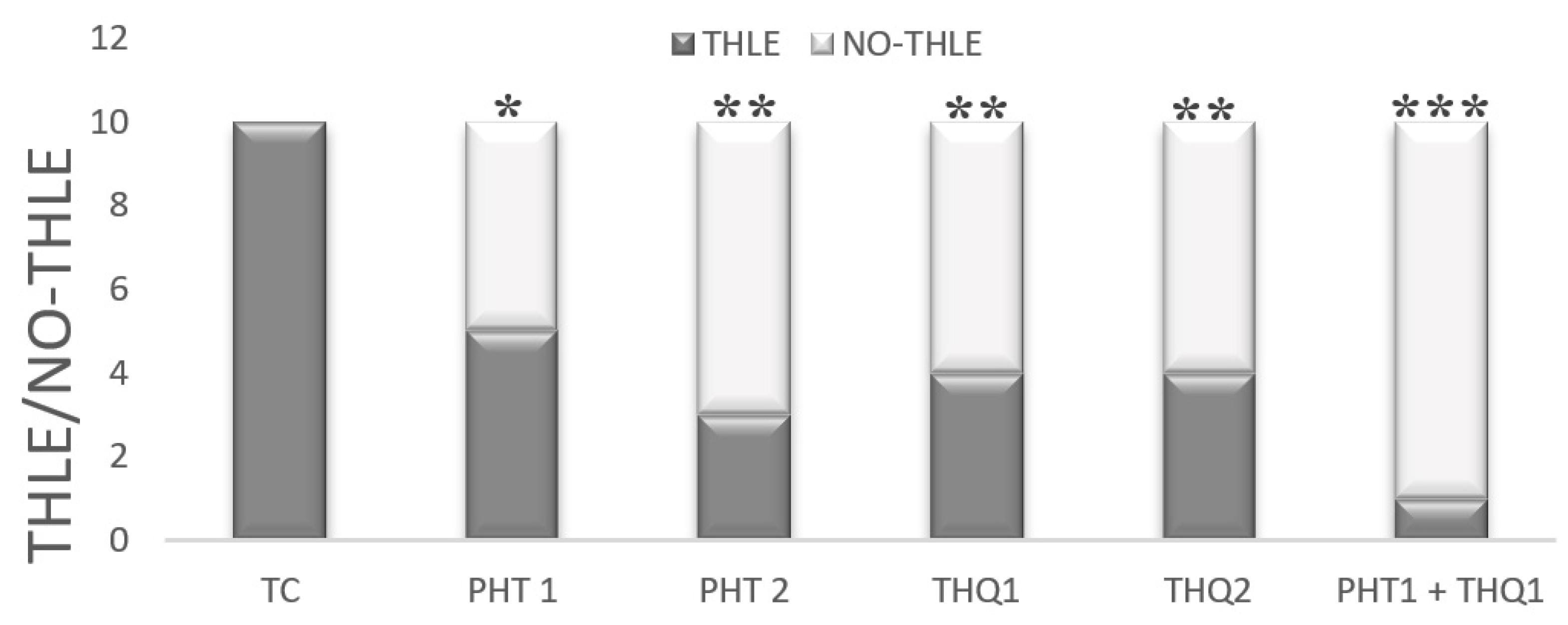
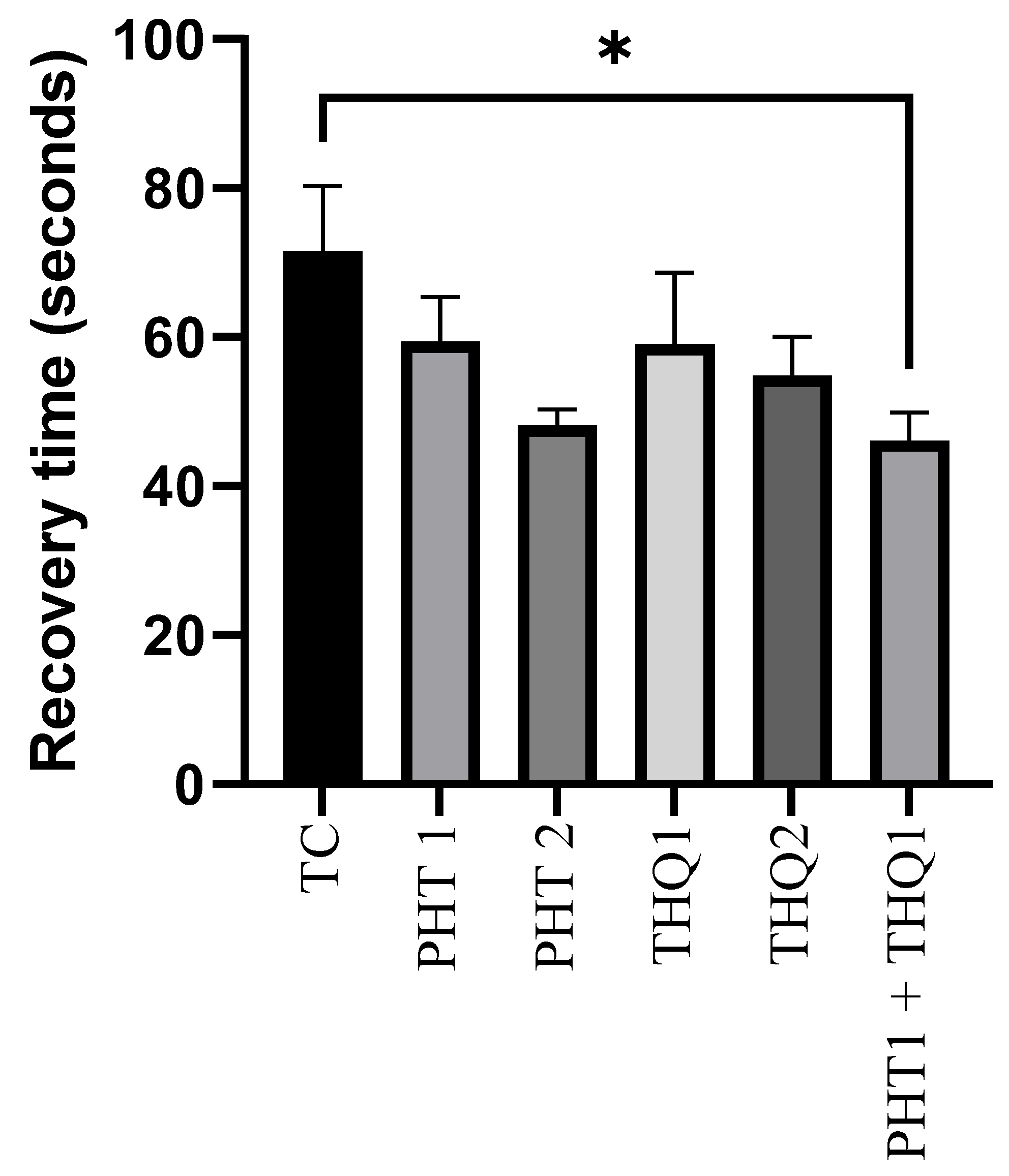
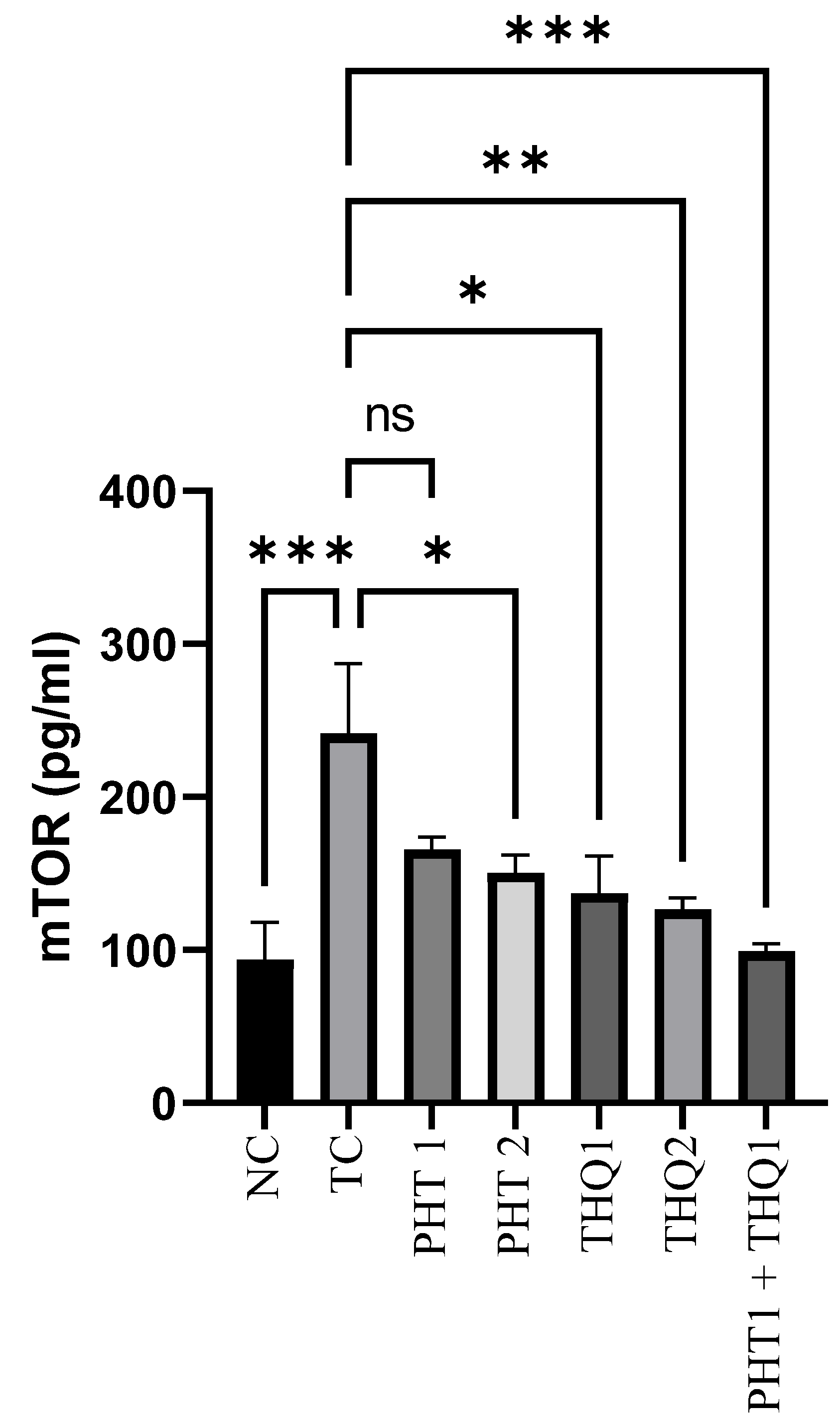
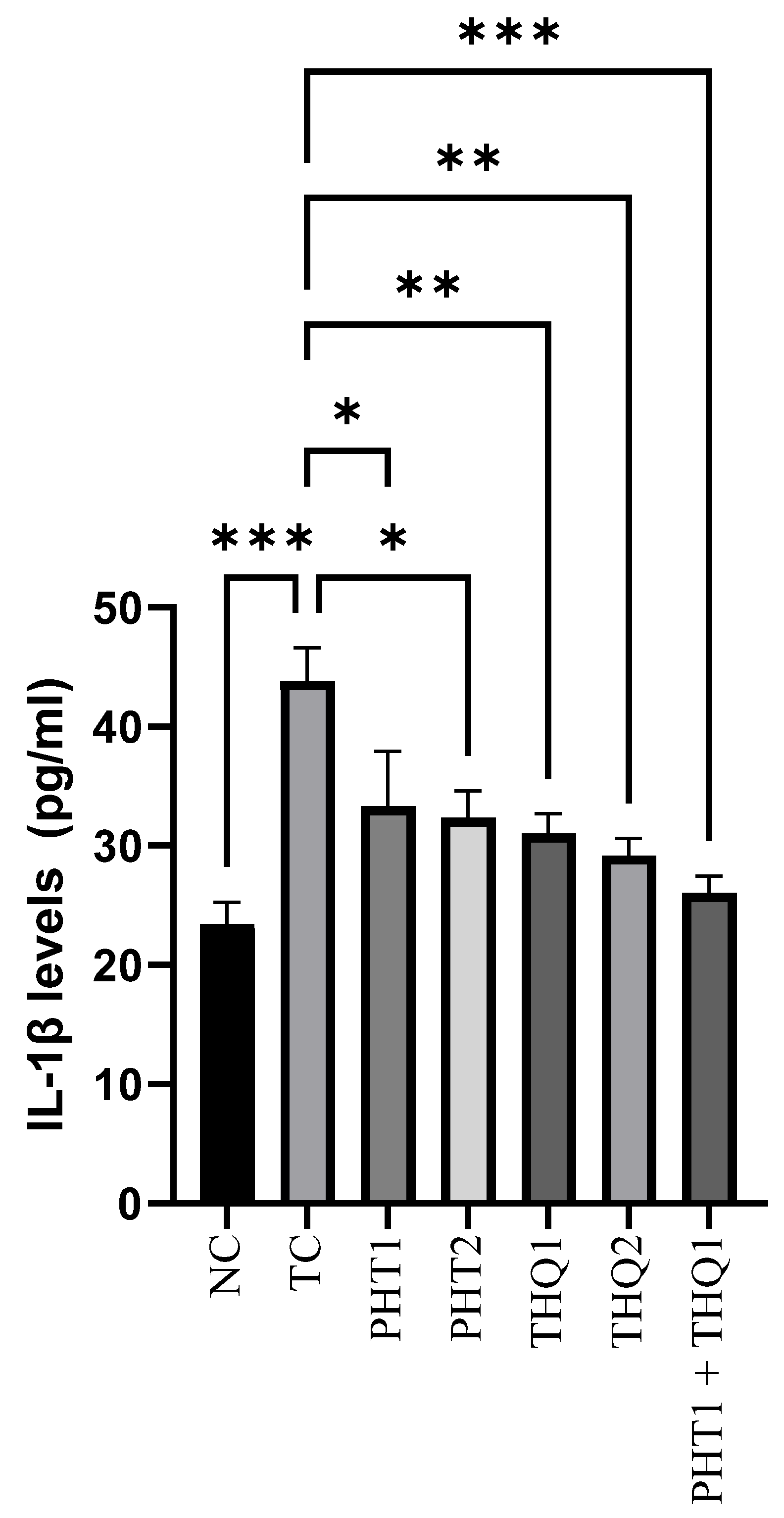
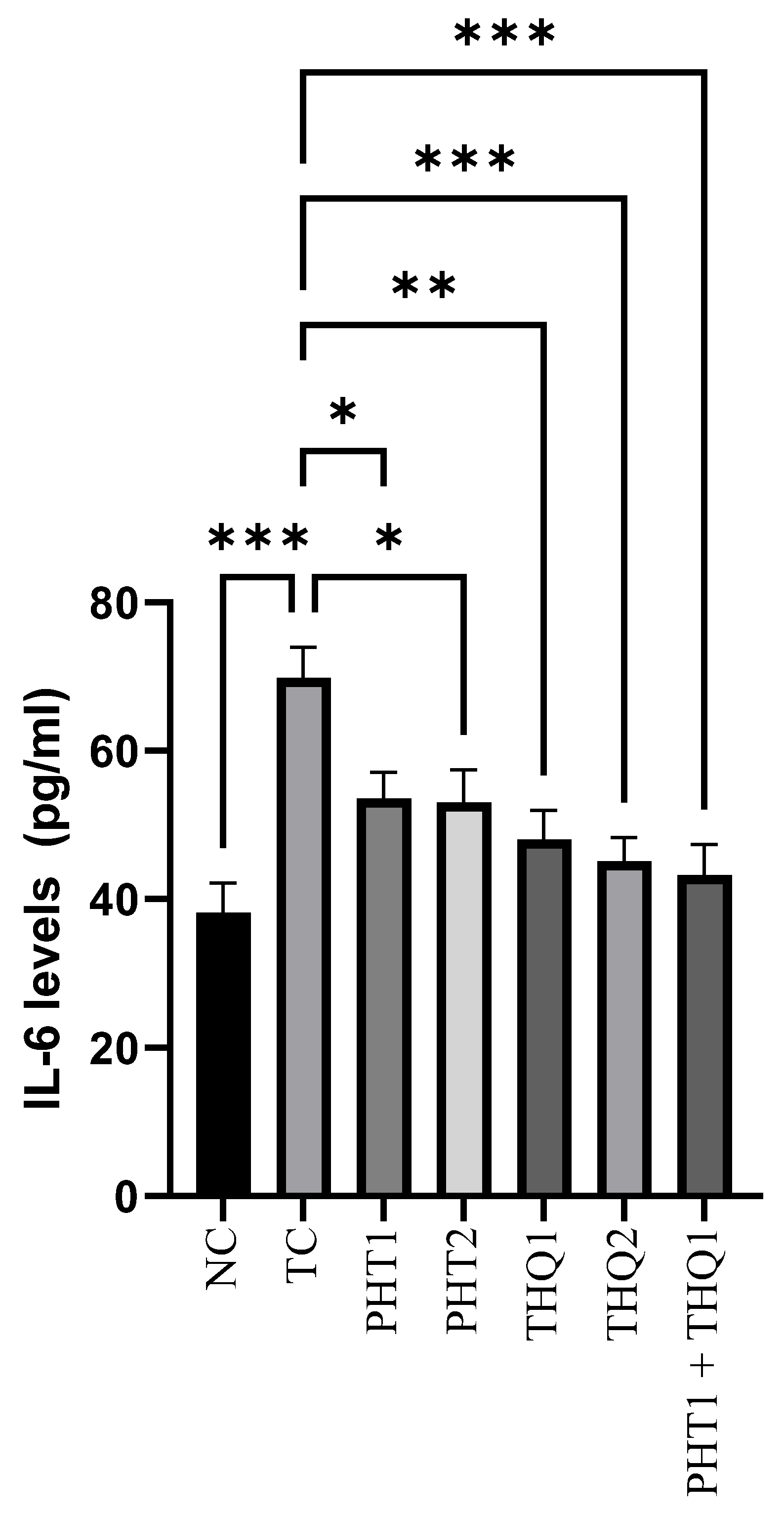
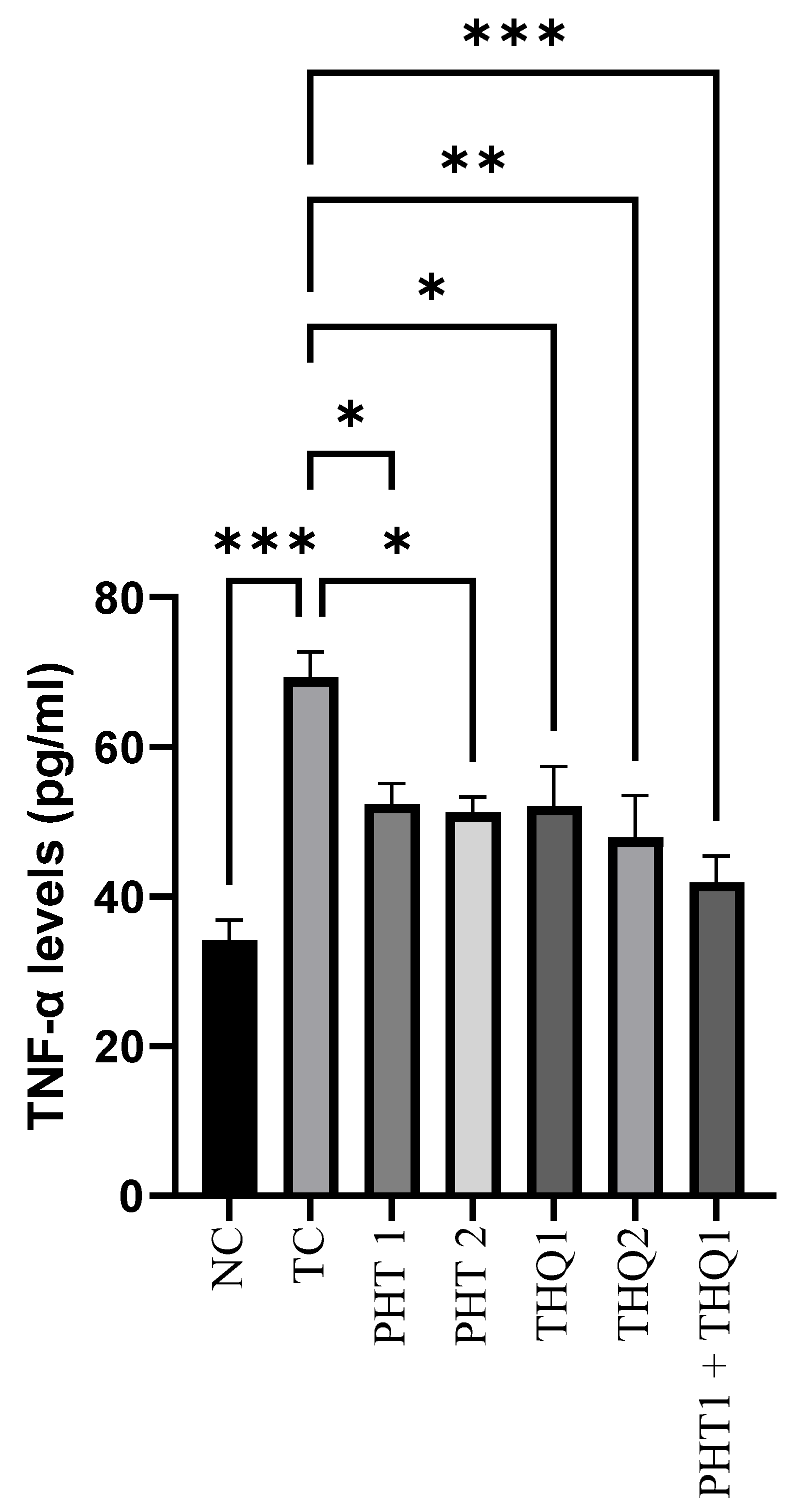
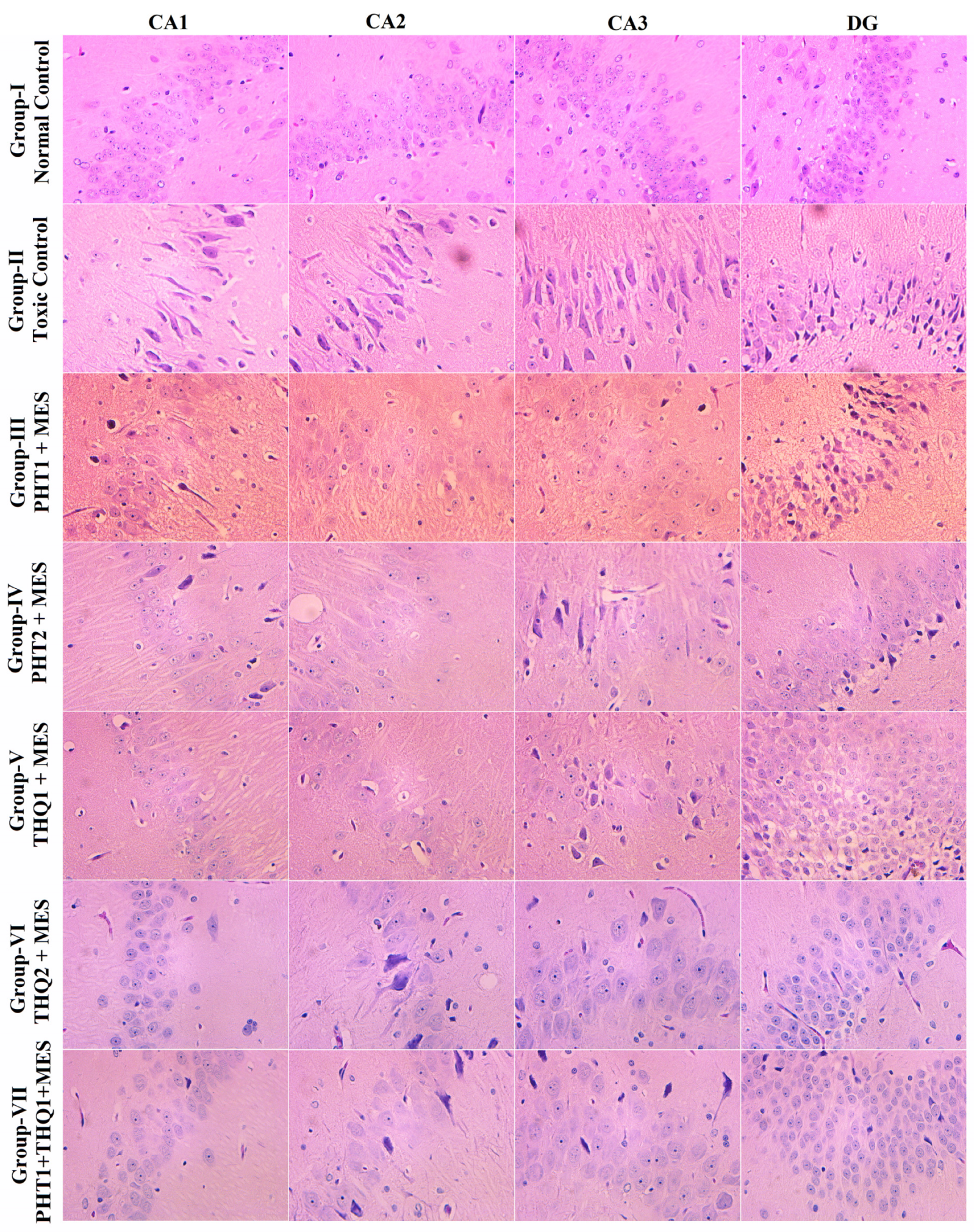
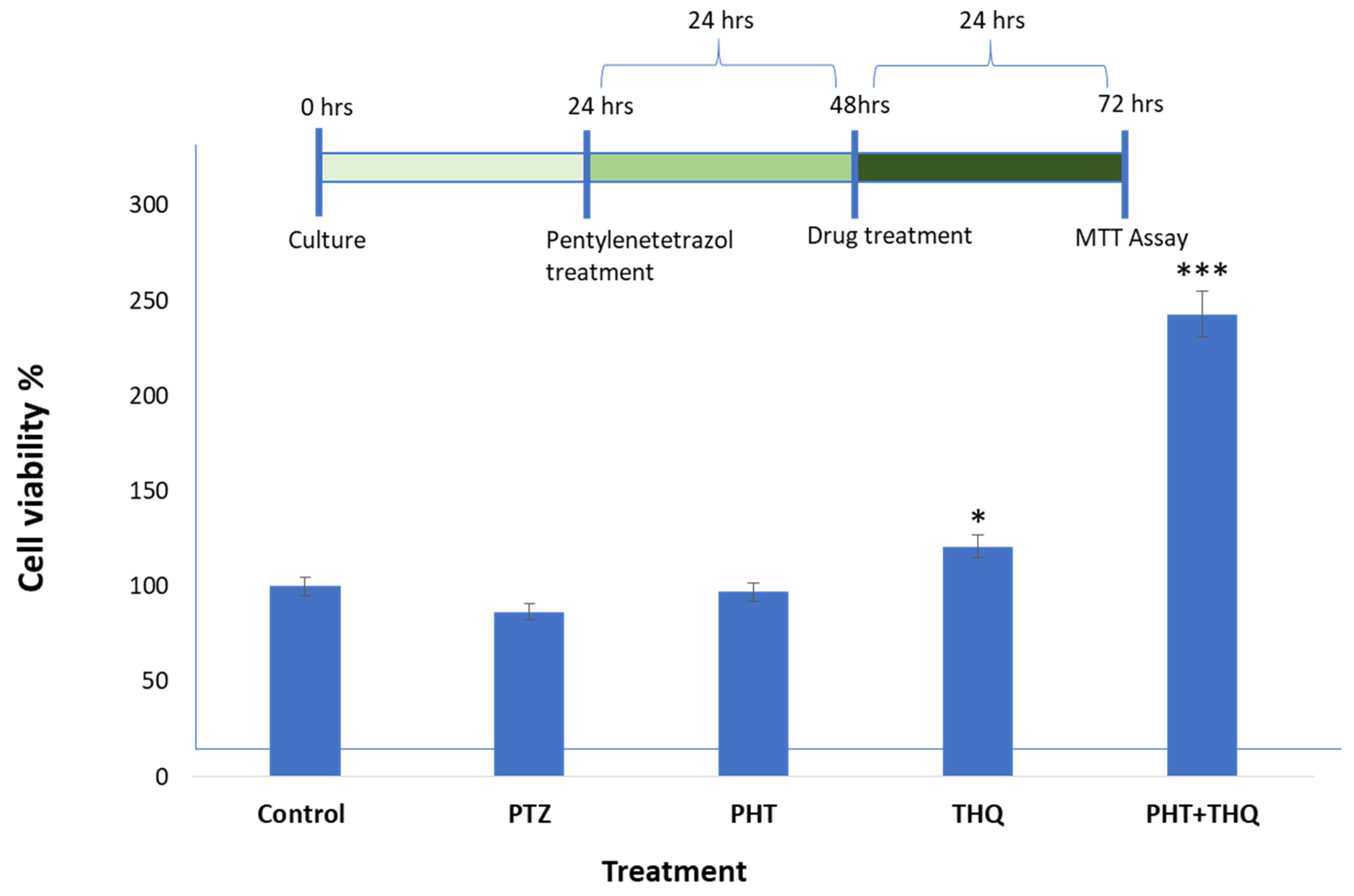
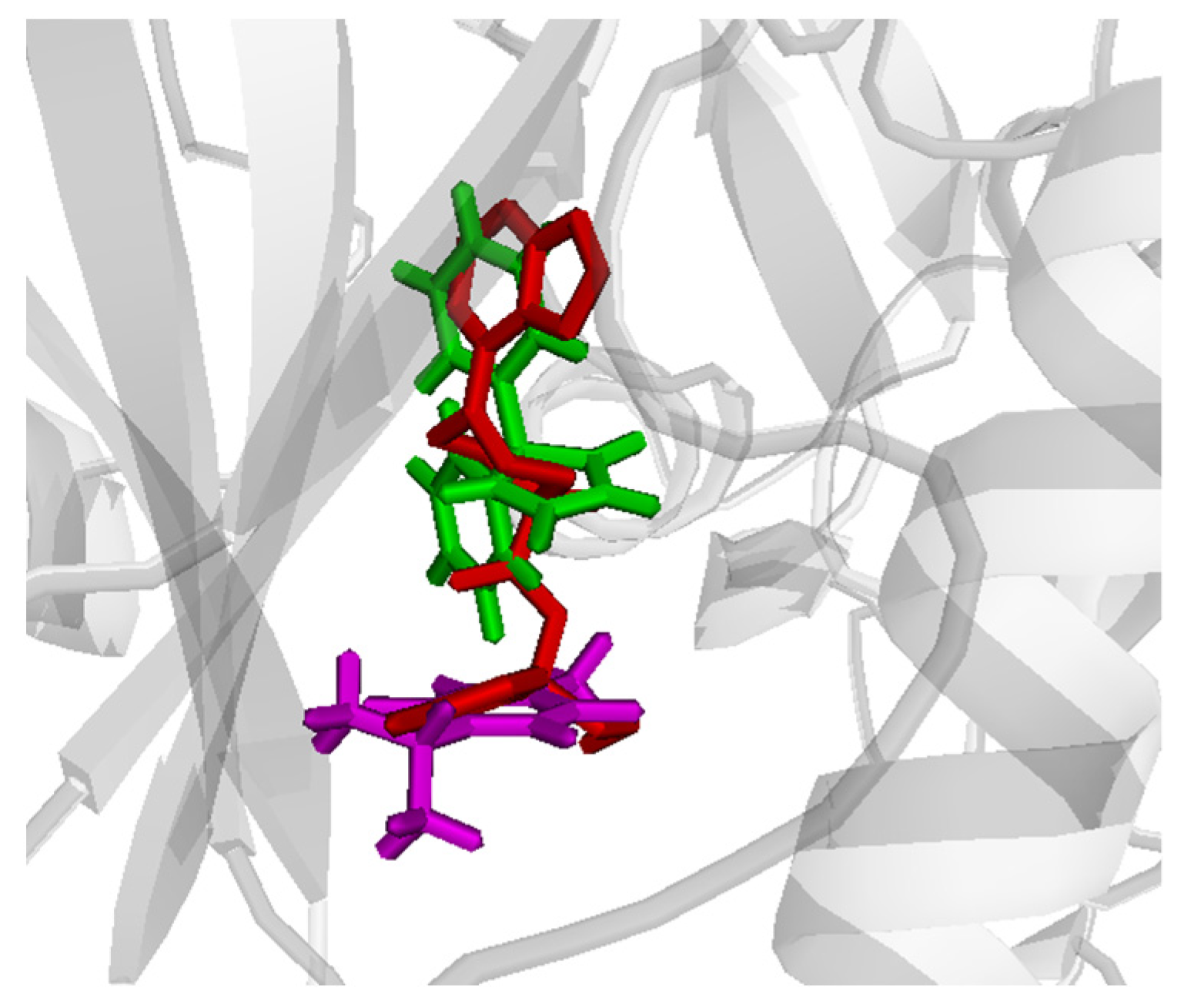
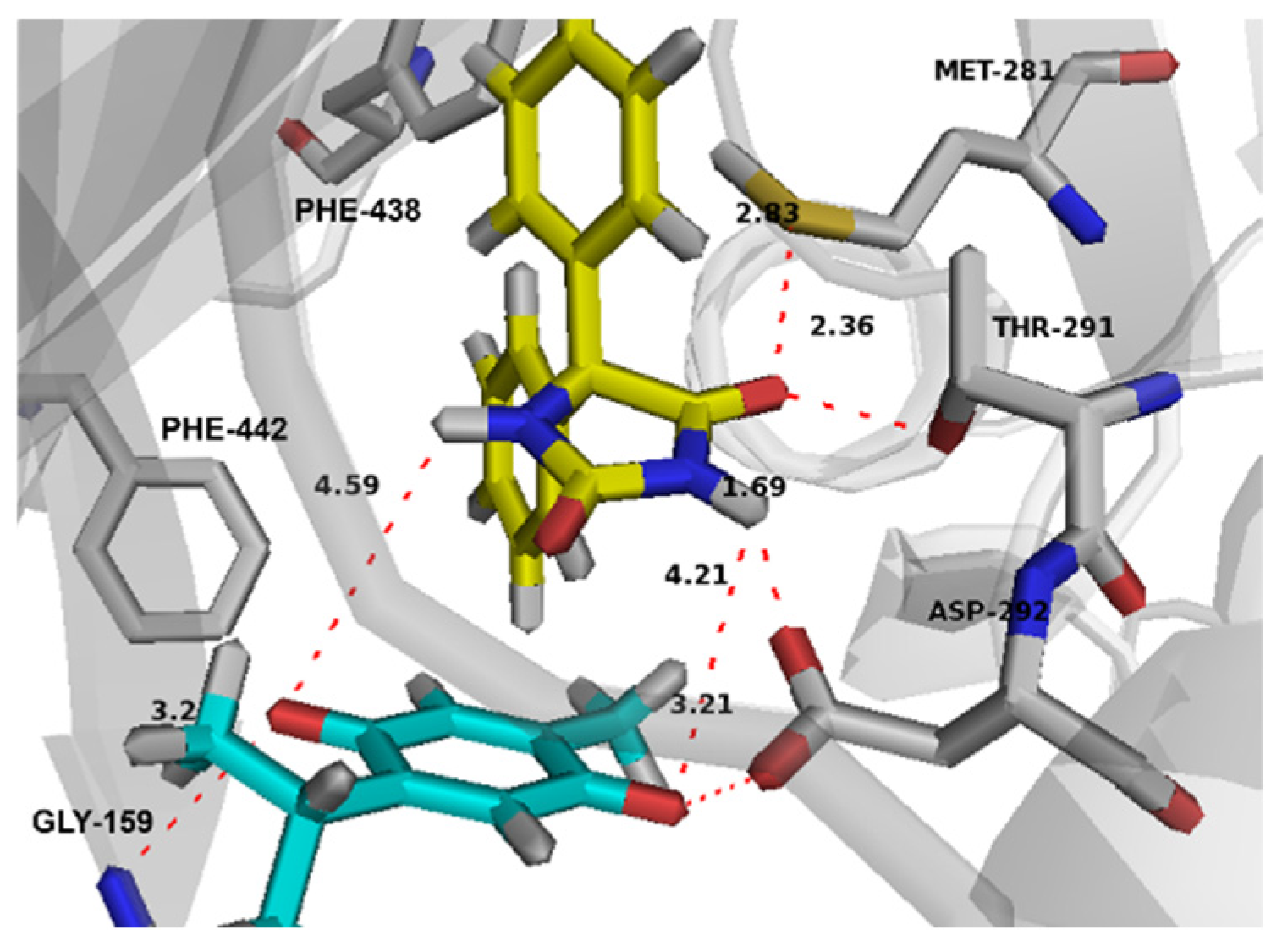
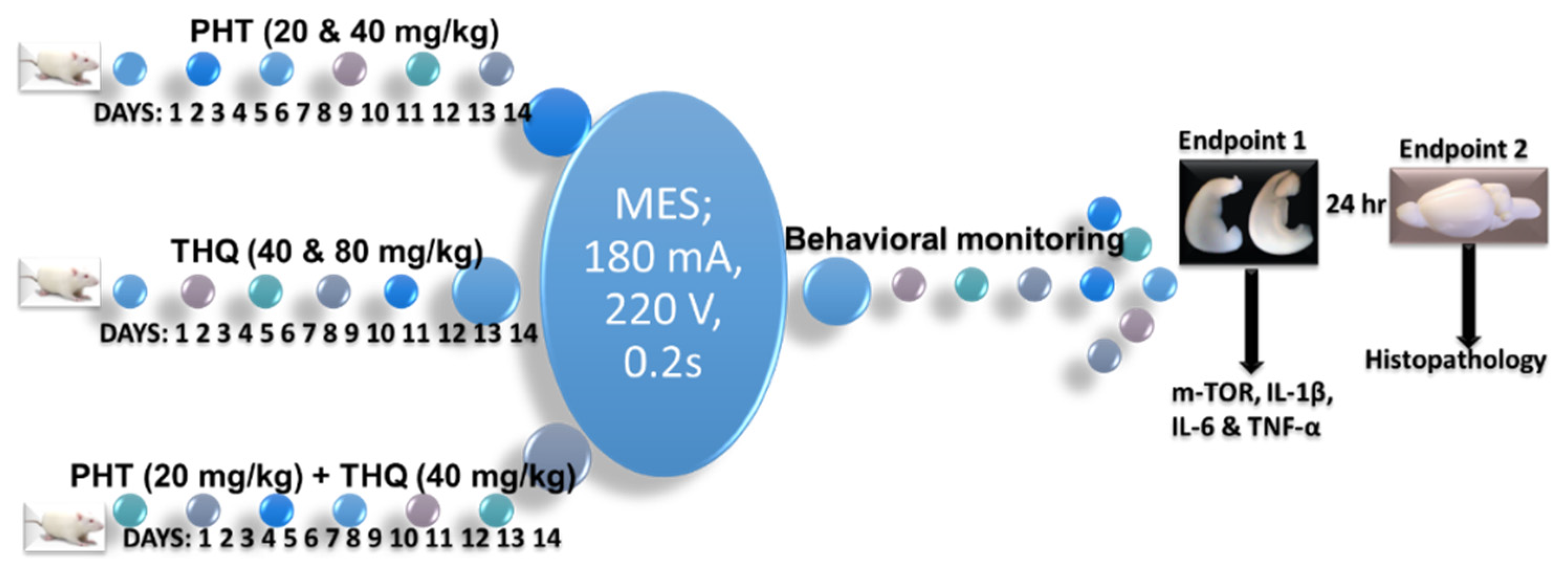
| Docking Score | ||||
|---|---|---|---|---|
| PHT 1st | PHT/THQ | THQ 1st | THQ/PHT | |
| Akt | −10.1 | −9.1 | −6.4 | −5.6 |
| PI3K | −9.4 | −9.2 | −5.9 | −6.5 |
Publisher’s Note: MDPI stays neutral with regard to jurisdictional claims in published maps and institutional affiliations. |
© 2021 by the authors. Licensee MDPI, Basel, Switzerland. This article is an open access article distributed under the terms and conditions of the Creative Commons Attribution (CC BY) license (https://creativecommons.org/licenses/by/4.0/).
Share and Cite
Pottoo, F.H.; Salahuddin, M.; Khan, F.A.; Alomar, F.; AL Dhamen, M.A.; Alhashim, A.F.; Alqattan, H.H.; Gomaa, M.S.; Alomary, M.N. Thymoquinone Potentiates the Effect of Phenytoin against Electroshock-Induced Convulsions in Rats by Reducing the Hyperactivation of m-TOR Pathway and Neuroinflammation: Evidence from In Vivo, In Vitro and Computational Studies. Pharmaceuticals 2021, 14, 1132. https://doi.org/10.3390/ph14111132
Pottoo FH, Salahuddin M, Khan FA, Alomar F, AL Dhamen MA, Alhashim AF, Alqattan HH, Gomaa MS, Alomary MN. Thymoquinone Potentiates the Effect of Phenytoin against Electroshock-Induced Convulsions in Rats by Reducing the Hyperactivation of m-TOR Pathway and Neuroinflammation: Evidence from In Vivo, In Vitro and Computational Studies. Pharmaceuticals. 2021; 14(11):1132. https://doi.org/10.3390/ph14111132
Chicago/Turabian StylePottoo, Faheem Hyder, Mohammed Salahuddin, Firdos Alam Khan, Fadhel Alomar, Marwa Abdullah AL Dhamen, Abrar Fouad Alhashim, Hawra Hussain Alqattan, Mohamed S. Gomaa, and Mohammad N. Alomary. 2021. "Thymoquinone Potentiates the Effect of Phenytoin against Electroshock-Induced Convulsions in Rats by Reducing the Hyperactivation of m-TOR Pathway and Neuroinflammation: Evidence from In Vivo, In Vitro and Computational Studies" Pharmaceuticals 14, no. 11: 1132. https://doi.org/10.3390/ph14111132
APA StylePottoo, F. H., Salahuddin, M., Khan, F. A., Alomar, F., AL Dhamen, M. A., Alhashim, A. F., Alqattan, H. H., Gomaa, M. S., & Alomary, M. N. (2021). Thymoquinone Potentiates the Effect of Phenytoin against Electroshock-Induced Convulsions in Rats by Reducing the Hyperactivation of m-TOR Pathway and Neuroinflammation: Evidence from In Vivo, In Vitro and Computational Studies. Pharmaceuticals, 14(11), 1132. https://doi.org/10.3390/ph14111132








